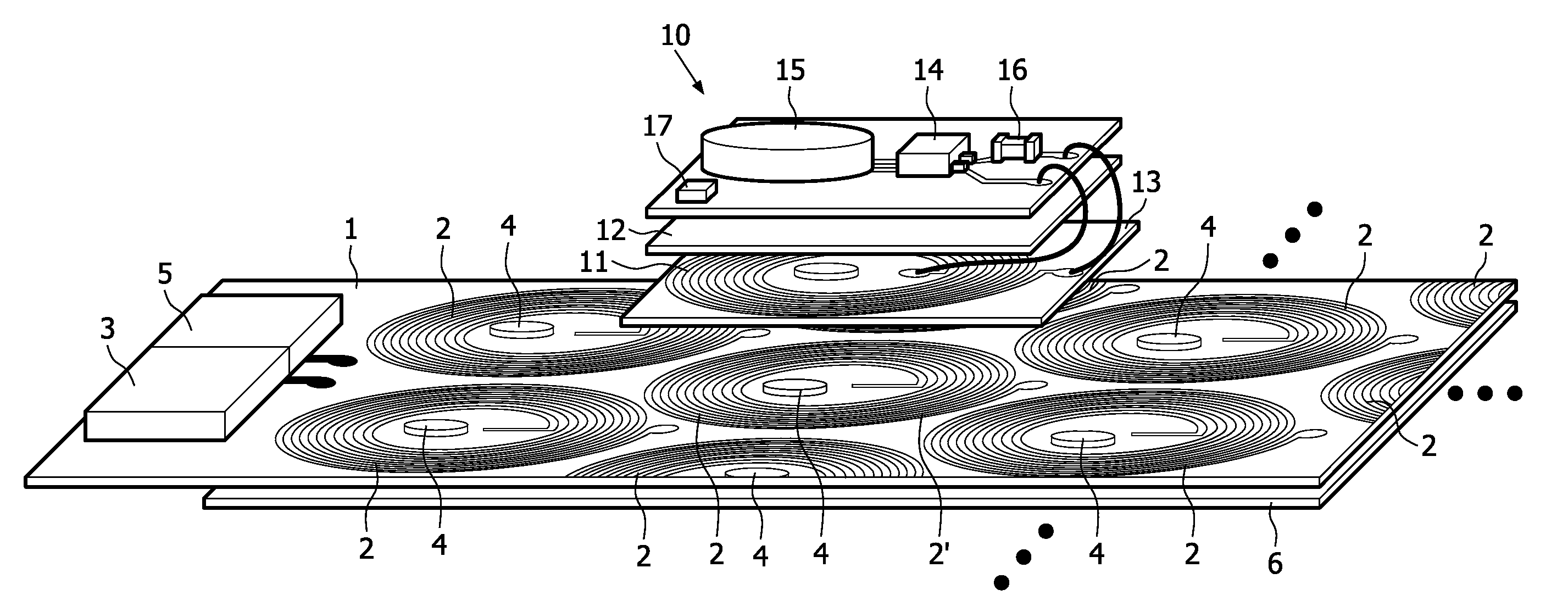Wireless power transmission system
a power transmission system and wireless technology, applied in the direction of transformers, inductances, transportation and packaging, etc., can solve the problems of unwanted interference with further electronic devices, and achieve the effect of reducing the magnetic far-field, efficient manufacturing of the base unit, and efficient cancellation of the magnetic far-field
- Summary
- Abstract
- Description
- Claims
- Application Information
AI Technical Summary
Benefits of technology
Problems solved by technology
Method used
Image
Examples
second embodiment
[0053]Further details of the invention are explained with reference to the FIGS. 2a-2c, which show schematic plan views of a wireless power transmission system in multiple operational states. Since alternating fields are used to induce a current in the receiving coil 11, FIG. 2a-2c show “snapshots” of the system at a given moment of time, to clarify the operation of the system.
[0054]According to the embodiment of FIG. 2a, a base unit 1 with an array of 3×4 coils 2 is provided to wirelessly transfer power to one or more devices 10 (not shown). One of the coils 2 is operated as a transmission circuit 2′ by the controller 3 to transfer power to a device 10 (not shown), arranged on top of the transmission circuit 2′. The transmission circuit 2′ is therefore supplied by the controller 3 with a first signal having a first phase, i.e. according to the “snapshot” of FIG. 2 in a first direction, as indicated by the arrows 7 and thus a first magnetic field 8 with a first phase, i.e. a first d...
third embodiment
[0069]To further enhance the compensation efficiency, it is possible to provide a separate controllable compensation power supply unit 45, as shown in FIG. 4a-4c. FIG. 4a shows a schematic plan view of a third embodiment in an operational state. The basic set up of the power transmission system according to the embodiment of FIG. 4a corresponds to the embodiment of FIG. 2a, especially the arrangement of the coils 2.
[0070]Each coil 2 can be connected either to the power supply unit 5, which provides the transmission coils 2′ with an ac voltage for power transmission (Ugen) or to the controllable compensation power supply 45 for providing an ac compensation voltage (Uc) to the compensation circuits 2″ using switches 31, as can be taken from FIG. 4b, which shows a schematic circuit diagram of the embodiment according to FIG. 4a. The controller 3 sets the compensation voltage according to equation (6), depending on the number of activated transmission circuits 2′ and compensation circui...
fourth embodiment
[0073]FIG. 5 shows a wireless power transmission system according to the invention in a schematic plan view in an operational state. In contrast to the embodiment of FIG. 2a, a dedicated compensation circuit 52 is provided on a periphery of the base unit 1, forming a transmission area, in which the coils 2 are arranged. The compensation circuit 52 is formed by a coil with multiple windings for generating the second magnetic field 21, which provides compensation in the magnetic far-field for the first magnetic field 8, generated by the one or more transmission circuits 2′. The compensation circuit 52 has the same number of turns as each of the coils 2. The coils 2 and the compensation circuit 52 are provided with an ac voltage by power supply unit 5.
[0074]FIGS. 6a and 6b show a schematic circuit diagram of the embodiment of FIG. 5. Each coil 2 can be switched to the ac supply voltage, provided by power supply unit 5. The compensation circuit 52 is connected to the same power supply u...
PUM
 Login to View More
Login to View More Abstract
Description
Claims
Application Information
 Login to View More
Login to View More - R&D
- Intellectual Property
- Life Sciences
- Materials
- Tech Scout
- Unparalleled Data Quality
- Higher Quality Content
- 60% Fewer Hallucinations
Browse by: Latest US Patents, China's latest patents, Technical Efficacy Thesaurus, Application Domain, Technology Topic, Popular Technical Reports.
© 2025 PatSnap. All rights reserved.Legal|Privacy policy|Modern Slavery Act Transparency Statement|Sitemap|About US| Contact US: help@patsnap.com



